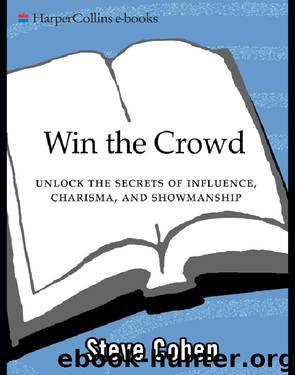Win the Crowd by Steve Cohen

Author:Steve Cohen
Language: eng
Format: epub
ISBN: 9780061757563
Publisher: HarperCollins
SERIES OF THREE
Hit ’em over the head, tie ’em in a knot, and get off.
—Advice from legendary Coney Island magician Al Flosso
Whether you are aware of it or not, your life is governed by the “series of three.” When you were a small child, this psychological principle was hardwired into your innermost psyche. Think back. All of your favorite stories had a beginning, a middle, and an end. There were three bears, and Aladdin was granted three wishes. Running races began with “Ready, set, go.” When you needed to pick up something heavy, you learned to “lift on three—one, two, three, lift!” And if you believe in Christianity, you learned about the Trinity.
Something just “feels right” when we hear or present information in chunks of three. Surely this feeling of comfort arises from familiarity. And since we are used to this triplicate format, we respond favorably when information is presented to us this way. When information is delivered in two parts, we expect or anticipate a third. If this never comes, we react unfavorably, as if something is missing. Likewise, when there are four parts, we react unfavorably because there was too much information provided.
Magicians utilize this comforting rhythm to condition the audience’s expectations in such a way that they miss the secret move. Not coincidentally, many magic tricks involve three objects: three cups, three rings, three ropes, three coins, three cards (think three-card monte). Most of these tricks have been constructed to create a degree of complacency after the third object is introduced. Let’s look at how you can use this concept to make your own nonmagical presentations more effective.
Comedians understand the series of three (at least the funny ones do!) and assemble their jokes in the following format: Joke 1—the setup, Joke 2—the build, Joke 3—the payoff. And, as long as the jokes are funny, audiences respond to this pattern predictably: first they chuckle, then they laugh solidly, and finally they have a good belly laugh.
Talk-show legend Johnny Carson qualified this lesson on an episode of The Tonight Show. During his monologue, as was often the case, Carson related jokes in rapid succession. The audience reacted exactly as I described above. But after the third joke, Carson told a fourth—to try and “top” himself. The result? Silence, on national television. And do you know what he said? “I should have stuck to the rule of three.”
Whenever you present information to people, organize it into chunks of three. If you offer up two bits of advice, people will feel that you’ve left them hanging. They’ll be waiting for the third item. Likewise, four is just one too many.
When I give an impromptu magic performance at a party or bar, I present three tricks. Although the informal show seems to be off the cuff, it’s been carefully planned out to represent a beginning, a middle, and an end.
For my more formal shows, I present nine major tricks (that’s three times three). The show is divided into three parts: a beginning, a middle, and an end.
Download
This site does not store any files on its server. We only index and link to content provided by other sites. Please contact the content providers to delete copyright contents if any and email us, we'll remove relevant links or contents immediately.
| Advertising | Consumer Behavior |
| Customer Service | Marketing |
| Public Relations | Sales & Selling |
| Search Engine Optimization |
Influence: The Psychology of Persuasion by Robert B. Cialdini(4739)
The Miracle Morning by Hal Elrod(4677)
The Hacking of the American Mind by Robert H. Lustig(4342)
Pre-Suasion: A Revolutionary Way to Influence and Persuade by Robert Cialdini(4188)
Unlabel: Selling You Without Selling Out by Marc Ecko(3630)
Ogilvy on Advertising by David Ogilvy(3559)
Hidden Persuasion: 33 psychological influence techniques in advertising by Marc Andrews & Matthijs van Leeuwen & Rick van Baaren(3523)
Purple Cow by Seth Godin(3169)
Who Can You Trust? by Rachel Botsman(3112)
Kick Ass in College: Highest Rated "How to Study in College" Book | 77 Ninja Study Skills Tips and Career Strategies | Motivational for College Students: A Guerrilla Guide to College Success by Fox Gunnar(3101)
The Marketing Plan Handbook: Develop Big-Picture Marketing Plans for Pennies on the Dollar by Robert W. Bly(3010)
This Is Marketing by Seth Godin(2994)
I Live in the Future & Here's How It Works by Nick Bilton(2963)
The Power of Broke by Daymond John(2936)
The Tipping Point by Malcolm Gladwell(2874)
Building a StoryBrand by Donald Miller(2865)
The 46 Rules of Genius: An Innovator's Guide to Creativity (Voices That Matter) by Marty Neumeier(2820)
Draw to Win: A Crash Course on How to Lead, Sell, and Innovate With Your Visual Mind by Dan Roam(2758)
Market Wizards by Jack D. Schwager(2674)
